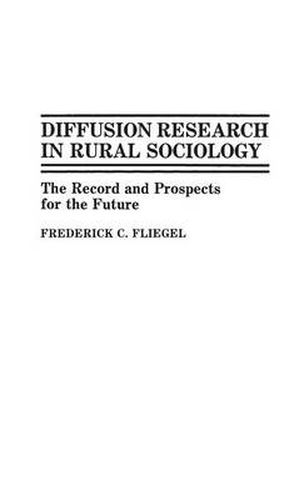Readings Newsletter
Become a Readings Member to make your shopping experience even easier.
Sign in or sign up for free!
You’re not far away from qualifying for FREE standard shipping within Australia
You’ve qualified for FREE standard shipping within Australia
The cart is loading…






In this work, Frederick C. Fliegel overviews and summarises research on the spread of innovations through rural populations. The volume gives detailed attention to the development and utilisation of diffusion research from the 1940s to 1970 and traces the creation of the classical model for explaining the spread of innovations. Because the classical model seemed inadequate when applied to the diffusion of innovations in lesser-developed countries after World War II, the model changed to accommodate new research. The book notes the role of diffusion research in developing countries after the World War II, the change of the classical model to include socioeconomic conditions peculiar to these countries, and the growth and development of diffusion research to the present day. The first part of this book provides an historical survey of diffusion research through 1970. The chapters in this section discuss the discovery of diffusion as a patterned process, the development of the classical model to explain diffusion as an information transfer, and the implementation of diffusion research in developing countries after 1945. The second part, devoted to recent trends, includes chapters on the further development and refinement of the classical model, the revival of interest in diffusion research, and the modern emphasis on conservation-oriented innovations rather than on ones that enhance production.
$9.00 standard shipping within Australia
FREE standard shipping within Australia for orders over $100.00
Express & International shipping calculated at checkout
In this work, Frederick C. Fliegel overviews and summarises research on the spread of innovations through rural populations. The volume gives detailed attention to the development and utilisation of diffusion research from the 1940s to 1970 and traces the creation of the classical model for explaining the spread of innovations. Because the classical model seemed inadequate when applied to the diffusion of innovations in lesser-developed countries after World War II, the model changed to accommodate new research. The book notes the role of diffusion research in developing countries after the World War II, the change of the classical model to include socioeconomic conditions peculiar to these countries, and the growth and development of diffusion research to the present day. The first part of this book provides an historical survey of diffusion research through 1970. The chapters in this section discuss the discovery of diffusion as a patterned process, the development of the classical model to explain diffusion as an information transfer, and the implementation of diffusion research in developing countries after 1945. The second part, devoted to recent trends, includes chapters on the further development and refinement of the classical model, the revival of interest in diffusion research, and the modern emphasis on conservation-oriented innovations rather than on ones that enhance production.